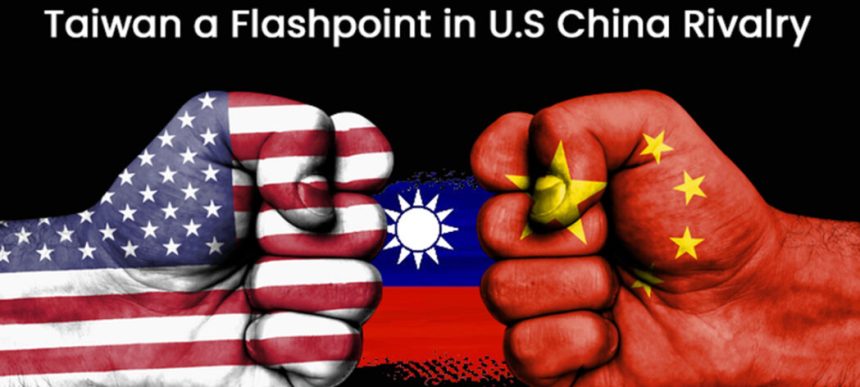“The United States and Canada colluded to provoke and stir up trouble … seriously jeopardizing peace and stability of the Taiwan Strait”, the Chinese People’s Liberation Army’s Eastern Theatre Command said in a statement. Tension rises, as China lashes out on the United States and Canada after sending warships to the Taiwan Strait.
A Look at The History
The tautness goes back in history. The division of China and Taiwan was a civil war corollary. The focus of the western colonists and merchants turned to China when it was under the control of the Qing Dynasty. Japan won the first Sino-Japanese war in 1895. Taiwan was surrendered to Japan by the Qing government, as an outcome. After world war II, Japan relinquished control of Taiwan back to China. As the republic of China was one of the victors of the war. With the consent of the United States and the United Kingdom, being China’s allies, it began to rule Taiwan.
Later, in the initial time period, a civil war in China broke out. The then leader Chiang Kai-shek was overthrown by Mao Zedong’s communist army.
In 1949, Chiang along with his Kuomintang (KMT) government relics, fled to Taiwan. The group was generally known as Mainland Chinese with 1.5m people. Despite the fact that the group was only 14% of the total population, it dominated the politics of Taiwan for a good many years. Chiang’s son, Chiang Ching-Kuo, permitted a process of democratization. After growing democratic movement pressure by local people who were resentful of the authoritarian rule.
President Lee Teng-hui, known as Taiwan’s “father of democracy”, led constitutional changes towards a more democratic political layout, which eventually led to the election of the island’s first non-KMT president, Chen Shui-bian, in 2000.
One Country, Two Systems
In the 1980s relationship between China and Taiwan was out of the woods. China proposed a formula “one country, two systems” which permitted Taiwan with certain autonomy if only it assents Chinese reunification. This system was established in Hong Kong with a motive to bring Taiwanese people back to the mainland.
One China Principle
In response, Taiwan rejected the offer but eased rules regarding visits and investments in China. Ever since 1949, Taiwan has been governed independently. However, China believes Taiwan as its an integral part and vows to unify Taiwan with the mainland. Asserting the “One China principle” concept that includes Taiwan as its integral part.
According to Beijing, Taiwan is bound by the 1992 consensus understanding attained between the Chinese Communist Party (CCP) and the Kuomintang (KMT) party of Taiwan. Albeit, the two sides have a different perspective of the consensus. With respect to China, the 1992 consensus agreement indicates, “the two sides of the strait belong to one China and would work together to seek national reunification.” On the other hand, KMT reflects “one China, different interpretations.”
Also Read: Afghanistan: The Economic Game Changer
The Kuomintang (KMT) drafted the constitution of Taiwan proceeds to recognize China, Mongolia, Taiwan, Tibet, and the South China Sea as part of the Republic of China (ROC). However, the KMT doesn’t uphold Taiwan’s independence and had reliably called for closer ties with Beijing. But the ongoing political race has transformed the narrative to shift the party’s stance on the 1992 consensus. The rival party of KMT the Democratic Progressive Party (DPP) has spurned the 1992 consensus as well the “one country two systems” framework.
China rejects Taiwan’s participation in the UN. Nonetheless, Taiwan is a member of more than 40 organizations, primarily regional. Additionally, Group of Seven (G7) countries called for Taiwan’s incorporation in WHO forums as Taiwan proved to be one of the most effective responses to the pandemic.
Fifteen states hold diplomatic ties with Taiwan. Yet, no government has ever held formal ties with rather China or Taiwan.
U.S developed its diplomatic ties with PRC in 1979 and revoked its defense treaty with ROC. Withal, the U.S sustains an unofficial relation with Taiwan furnishing self-defense equipment for military purposes. China has always condemned and urged Washington to cease its relationship with Taiwan and bring the warheads supply to an end.
The United States elucidates its relationship on the grounds of maintaining peace and stability in the Taiwan Strait. Affirming it does not support Taiwan as an independent state. Following the approach of “One China Policy”, the U.S Congress passed the Taiwan Relations Act in 1979.
U.S-China Power Politics in Taiwan
The power dynamics have shifted from violence to wealth. Ever since the industrial revolution violence has taken a setback. History has proved that it’s not just the military that’s vital for a state’s survival, there are significant other factors essential. Primarily the economy.
In the 21st century, the nature of war has evolved from the military to the economy. The international power politics center economy as a prime source of hegemony. The world is now driven by how powerful an economy you’re in the international arena. Economic warfare is a preferable alternative to that military warfare. Since economic warfare has been able to achieve its aims. Economic weapons have been used to help our allies to wear out our enemies.
Aslo Read: US Failure in Afghanistan: Who to Blame?
In the context of US-China, Taiwan plays a very crucial role for both, in terms of economy. The Taiwan Semiconductor Manufacturing Co. (TSMC) is the leading manufacturer of semiconductor chips that helps power our phones, laptops, cars, etc. World-leading companies Apple, Intel, Qualcomm, AMD, and Nvidia are its clients. TSMC has a whooping influence over the global economy providing 1.67% chips everywhere. At present, the world is driven by one chip maker country that is Taiwan.
China has been controlling the world-leading chip industry of Taiwan. Beijing is Taipei’s largest trading partner. And yet, Taiwan has and is still struggling for its recognition as an independent democratic state, but the growing power of China overshadows it. Leaving millions of Taiwanese to travel, trade, negotiate and even participate in Olympics under the “Chinese Taipei” identity. President Xi Jing Ping of PRC states reunification with Taiwan is critical to China’s national “rejuvenation.” And that China will resolve the Taiwan matter without any foreign intervention.
To gain hegemony over the global economy, Taiwan is crucial. After being a regional hegemon, China is aiming for global dominance with a gentler option, economy. China with a soft image stepped into the world of economy, taking over the world market even in the most unreachable areas. The inauguration of the Belt Road Initiative is a strategic economic approach by China.
However, the U.S is skeptical of China’s dominance over the global economic market. Washington has taken countermeasures such as imposing economic sanctions on China to counter its global influence and now the U.S has been supplying warheads to Taiwan for their military. This U.S intervention in Taiwan is seen as the bone of contention by China.
Beijing has slammed the U.S and Canada for their warhead supplies to the Taiwan strait recently has triggered concerns internationally. In early October 2021, a record number of Chinese military jets were sent into the air defense zone of Taiwan. China views Taiwan as a separatist province and for Taiwan, they are an independent sovereign state. Taiwan has been complaining about repeated military aggression by China over the years. According to Taiwan, it damages regional peace.
The U.S validates its intervention on the grounds of democratic values. Washington values Taiwan’s autonomous democracy nevertheless does not recognize it as an independent state. Secondly, Under the 1980’s Taiwan Relations Act which “The United States shall provide Taiwan with arms of a defensive character and shall maintain the capacity of the United States to resist any resort to force or other forms of coercion that would jeopardize the security, or social or economic system, of the people of Taiwan.” Washington has a right to defend Taiwan.
But Is It Really Peace?
Regardless of peace ideals and democratic values, the United States evidently understands the significance of Taiwan in the economic world and likewise to China as well. Over the decades Taiwan has been of grave concern or simply a political-military flashpoint in the US-China relations. Since 2016, Taiwan’s election of the president, Tsai Ing-wen of the Democratic Progressive Party which was founded on the basis of favoring independence for the island, has triggered the residing tensions between Taiwan and China.
In context to this U.S has offered more pragmatic support for Taiwanese over the years on many different fronts. The prior trump administration incorporated the island into indo-pacific. Extended official contacts with Taiwan and increased arms sales. Presently, the Biden administration affirmed the United States’ commitment to defending the island if attacked. Supporting Taiwan’s defense capabilities and aiming for Taipei to play an international role.
Nonetheless, Beijing aims to resolve the Taiwan issue on its own through a unifying strategy, rejecting U.S interference in the matter.
U.S and China have deep-rooted interests when it comes to Taiwan island. The interest is of course economic in nature. China has taken over the tech world with the TSMC chip market leaving the U.S behind. For the U.S, Taiwan is a way to counter China’s global influence. Needless to say, the two power needs to resolve the conflict through diplomatic measures with a more pragmatic approach, or else this will lead to a wider conflict in the future.






